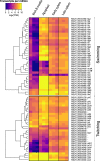Dynamic expression of Ralstonia solanacearum virulence factors and metabolism-controlling genes during plant infection
- PMID: 33750302
- PMCID: PMC7941725
- DOI: 10.1186/s12864-021-07457-w
Dynamic expression of Ralstonia solanacearum virulence factors and metabolism-controlling genes during plant infection
Abstract
Background: Ralstonia solanacearum is the causal agent of bacterial wilt, a devastating plant disease responsible for serious economic losses especially on potato, tomato, and other solanaceous plant species in temperate countries. In R. solanacearum, gene expression analysis has been key to unravel many virulence determinants as well as their regulatory networks. However, most of these assays have been performed using either bacteria grown in minimal medium or in planta, after symptom onset, which occurs at late stages of colonization. Thus, little is known about the genetic program that coordinates virulence gene expression and metabolic adaptation along the different stages of plant infection by R. solanacearum.
Results: We performed an RNA-sequencing analysis of the transcriptome of bacteria recovered from potato apoplast and from the xylem of asymptomatic or wilted potato plants, which correspond to three different conditions (Apoplast, Early and Late xylem). Our results show dynamic expression of metabolism-controlling genes and virulence factors during parasitic growth inside the plant. Flagellar motility genes were especially up-regulated in the apoplast and twitching motility genes showed a more sustained expression in planta regardless of the condition. Xylem-induced genes included virulence genes, such as the type III secretion system (T3SS) and most of its related effectors and nitrogen utilisation genes. The upstream regulators of the T3SS were exclusively up-regulated in the apoplast, preceding the induction of their downstream targets. Finally, a large subset of genes involved in central metabolism was exclusively down-regulated in the xylem at late infection stages.
Conclusions: This is the first report describing R. solanacearum dynamic transcriptional changes within the plant during infection. Our data define four main genetic programmes that define gene pathogen physiology during plant colonisation. The described expression of virulence genes, which might reflect bacterial states in different infection stages, provides key information on the R. solanacearum potato infection process.
Keywords: Apoplast; Bacterial wilt; Dynamic gene expression; Effectors; Metabolism; RNAseq; Ralstonia solanacearum; T3SS; Virulence factors; Xylem.
Conflict of interest statement
The authors declare that they have no competing interests.
Figures






References
-
- Coll NS, Valls M. Current knowledge on the Ralstonia solanacearum type III secretion system. Microb Biotechnol [Internet]. 2013 Nov [cited 2020 Sep 18];6(6):614–20. Available from: https://www.ncbi.nlm.nih.gov/pmc/articles/PMC3815929/ - PMC - PubMed
-
- Peeters N, Guidot A, Vailleau F, Valls M. Ralstonia solanacearum, a widespread bacterial plant pathogen in the post-genomic era. Mol Plant Pathol [Internet]. 2013 Sep 1 [cited 2020 Sep 18];14(7):651–62. Available from: https://bsppjournals.onlinelibrary.wiley.com/doi/full/10.1111/mpp.12038 - DOI - PMC - PubMed
-
- Ciampi L, Sequeira L, French ER. Latent infection of potato tubers by Pseudomonas solanacearum. Am Potato J. 1980;57(8):377–386. doi: 10.1007/BF02854329. - DOI
-
- Janse JD, Van Den Beld HE, Elphinstone J, Simpkins S, Tjou-Tam-Sin NNA, Van Vaerenbergh J. Introduction to Europe of Ralstonia solanacearum biovar 2, race 3 in Pelargonium zonale cuttings. J Plant Pathol. 2004;86(2):147–155.
MeSH terms
Substances
Grants and funding
LinkOut - more resources
Full Text Sources
Other Literature Sources

